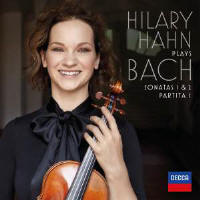Texte paru dans: / Appeared in: |
|
|
Outil de traduction (Très approximatif) |
|
|
Reviewer: Rob Cowan For all the appreciable virtues offered by recent contenders in the Bach Sonatas and Partitas field, I cannot think of a single performer who begins to compare with Hilary Hahn. This is quite simply magnificent violin-playing, the sort that while you’re listening to it convinces you that the music couldn’t possibly be played any other way. One only need sample the elevated flight of the A minor Sonata’s opening Grave, playing that combines candid expression with expertly judged pacing, to confirm the extent of Hahn’s achievement. The fugues of both the A minor and G minor Sonatas abound in such ploys as ‘statement and echo’, variegated attack, carefully placed diminuendos and crescendos, a warming legato and chords that are strong without resorting to textural coarseness. Compare the first minute or so of the A minor Fugue with the Fugue from the C major Sonata included on Hahn’s first solo Bach album (Sony, 2/98 – which features the other half of the solo cycle) and you soon realise just how far she’s come since her teenage years, the tempo marginally more mobile and the variety of nuance and tone on offer so much wider than it had been. And what about the A minor Sonata’s gently pulsing Andante? To call this playing miraculous might seem like hyperbolic overkill, until you actually hear it for yourself. Not since Heifetz, whose approach is similarly vocal, have I heard such eloquent reportage of this heavenly music, Hahn keeping the gently palpitating accompaniment audibly supportive of the top line, her sound consistently warm, her tone rich but never overbearing, the general mood solemnly imploring. Come the midway point (at around 2'46") and she cues a brief pause for breath, which in turn allows us room for thought. Indeed, I would cite this track in particular (track 15) as an appropriate sampling point for anyone who normally finds Bach’s solo violin music a bit of a slog to listen to, the sound and approach are so utterly seductive. The opening of the G minor Sonata’s Adagio is uncommonly broad, the ensuing monologue full of light and shade, the first four notes of the fugue that follows built on a subtle crescendo. As with the A minor Sonata’s Fugue, Hahn makes expressive capital out of Bach’s arpeggiated writing (which at 2'03" excitedly takes flight) with never a hint of ugliness. The B minor Partita is no less beautiful, the Allemande morphing into its ‘double’ on an even keel, Hahn here employing finely spun vibrato. All this made me wish that she’d now go back and re-record that first (Sony) programme so that we could have all six solo works captured in what is surely her prime. The actual recording process was interesting in that Hahn started working on the new album some six years ago. She then shelved what she had done and went back to the project five years later, so what we have here was recorded between June 2012 and June 2017, the majority from the latest sessions. All this is typical of Hahn’s almost Gouldian approach to recording, and the results are spectacular.
As to digital
comparisons (and apologies in advance for the seemingly unavoidable gender bias)
there will be those who favour the ascetic tone and more demonstrable
flexibility of, say, Alina Ibragimova (Hyperion, 11/09); or Julia Fischer (Pentatone,
6/05), an imaginative player who steers a course somewhere between Hahn and
Ibragimova; or Rachel Podger (Channel Classics, 7/99, 12/99) whose cool, limpid
handling of the music also works well. Collectors who prefer this period-savvy
approach are therefore very well served. As ever, the ‘problem’ of period
performance versus post-Romantic interpretation will open a critical chasm. It
always does. But I cannot pose as a fraud just because my tastes, and the tastes
of various others, happen to run counter to current trends in Bach scholarship.
As Nicholas Kenyon meaningfully asked in our October issue, what did Bach sound
like in his day? More to the point, in this particular context, would hearing
Hilary Hahn’s performing gifts have dazzled him with new-found expressive
potential for an instrument that he loved and played himself? What would his
violin music have sounded like thereafter? We could speculate endlessly but I
rather suspect that he would have loved what he heard and acted accordingly.
Maybe it’s a generational thing; but, speaking personally, Hahn touches my heart
in a way that the players quoted above don’t, so while scribbling this ‘rave’
review (which it undoubtedly is) I can at least acquit myself with a good
conscience. You should by now know whether or not this CD is for you. I adored
it. |
|




